Introduction
Having been defeated on land, the Americans turned their attention to gaining control of the British supply line on the waterways of the Great Lakes. They sent
Oliver Perry of the U.S. Navy to take command of the naval forces on Lake Erie. The Americans were building two ships at Presque Isle (now Erie, Pennsylvania). As the
Royal Navy was blockading the Atlantic seaboard, there were plenty of experienced sailors to send to the Great Lakes. Supplies were brought from Pittsburgh and Philadelphia.
In contrast to this, the British had fewer resources to devote to shipbuilding. They started one ship in the Navy Yard at
Amherstburg. They had few carpenters and the ships' supplies had to be imported from England. The supplies meant for the
H.M.S. Detroit were destroyed at York, when the Americans captured the town in April 1813.
The British put Robert Barclay in command of the fleet in Lake Erie in June. On arriving, he found the few vessels that were ready lacked most basic supplies, including cannons. His letters written during the summer are full of constant demands for equipment and trained seamen.
|

Blunderbuss

Boarding axe
|
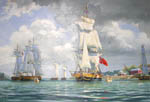
The British fleet leaving Amherstburg
|
Barclay had to borrow soldiers from the 41st Regiment and the Royal Newfoundland Regiment to act as sailors and marines for his ships. Despite his problems, he managed to get an early lead on Perry's efforts. For weeks, he took his small squadron out, blockading Perry's ships from leaving Presque Isle.
At the beginning of August 1813, Barclay left his blockade for two days, thinking the low water levels would keep his enemy inside the bay. But Perry managed to drag his ships over the sandbar that blocked the mouth of Presque Isle's
harbour, thus freeing his boats. Now he had the advantage. Perry's squadron could stop the British in Amherstburg from receiving any supplies.
|
On Sept. 9, Barclay and his small fleet of 6 ships left the Detroit River and entered Lake Erie, looking for the enemy. He found them early on the morning of the 10th, at Put-In Bay. Barclay's six ships
(Detroit, Queen Charlotte, Lady Prevost, General Hunter, Little Belt and Chippawa) lined up against Perry's nine
(Lawrence, Niagara, Caledonia, Ariel, Somers, Scorpion, Porcupine, Tigress and
Trippe). At first the wind favoured the British ships, but at 10 a.m. the wind shifted to the Americans' advantage.
|
The battle opened around 11:45 a.m. The roar of the guns could be heard in
Amherstburg. The British gained an early advantage by concentrating their fire on the
Lawrence and crippling it. But Perry managed to switch ships at 2:30 p.m. and took command of the American ships from the
Niagara. By getting in close, the Niagara did heavy damage to the Detroit and the
Queen Charlotte. While Barclay was being treated for wounds below deck, the two main British ships collided. Perry seized the opportunity and, taking his ships through the British line, bombarded ships on both sides. After he repeated this
manoeuvre, the British surrendered. The
Chippawa and Little Belt tried to flee to the safety of
Amherstburg, but were caught. Perry and the American squadron had captured all six British
ships.
|
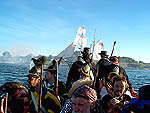
Re-enactors in a naval battle
|
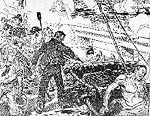
The Battle of Lake Erie
|
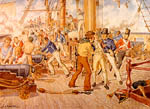
The Battle of Lake Erie
|
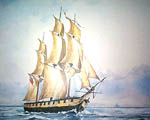
H.M.S. Detroit |
|
|
|
See more: Captain Robert Barclay.
See more: Commodore Oliver Perry.
See more: Verchères on the preparations at Amherstburg.
See more: H.M.S. Detroit.
See more: Barclay's letter to Sir James Yeo describing the battle.
See more: Map of the
battle. (See the
transcription)
(See the
transcription)






